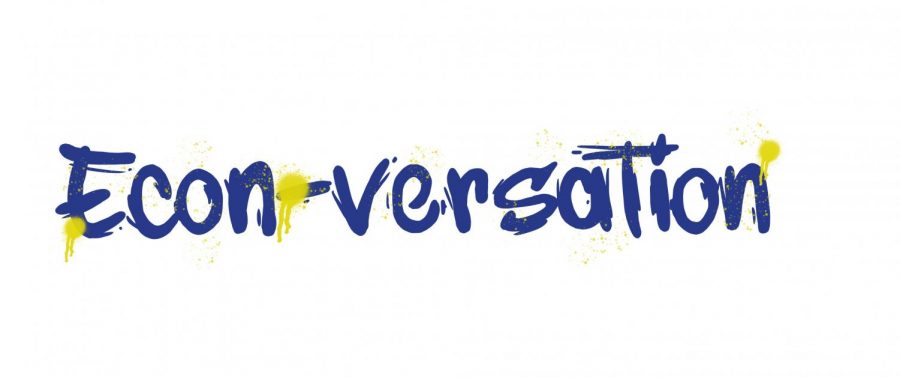The Econ-versation: Special Feature – Understanding the Federal Reserve
December 5, 2019
Depending on the state of the economy, the Federal Reserve (Fed), the central bank of the United States, indirectly influences the target interest rate it establishes through increasing or decreasing the money supply. The Fed’s primary goal is usually to preserve a stable macroeconomic environment. To do so, the Fed aims to manage unemployment and inflation in addition to influencing other factors such as investment, consumer confidence and consumption.
The rate the Fed alters — known as the federal funds rate — is the rate at which banks lend and borrow among each other. Changes to this target rate then influence other interest rates such as those for mortgages or other loans. Therefore, even a small change to the interest rate — or an expectation that it may change — can influence consumption or investment behavior.
When the economy is performing poorly, the standard procedure is for the Fed to lower the federal funds rate to boost investment and consumer spending. When the economy is overheating, the Fed tends to increase its target rate to slow investment and consumer spending. This general stabilization policy stems from the Keynesian economic school of thought.
During the 2008 financial crisis, the Fed implemented Keynesian stabilization policy as the target interest rate plummeted to stimulate the economy. Since then, the Fed has been working to gradually increase the federal funds rate to pre-crisis levels, which were around 4.50 to 5.25 percent. However, now with an uncertain economy, the Fed is taking preemptive measures to ensure the economy against a recession.
Beginning in July, the Fed cut the target rate by 25 basis points (0.25 percent) for the first time since 2008. Two more cuts, each of 25 basis points, followed in September and October. While some believe these rate cuts are unnecessary insurance cuts, they are intended to safeguard the economy against uncertainty from a global slowdown in manufacturing and the trade war with China.
To provide additional support for the recent rate cuts, inflation has been below the Fed’s target of two percent and the yield curve — a graph plotting interest yields of bonds over various maturity dates — has been inverted, which is an indicator of an impending recession. The inverted yield curve signals that short-term bonds have higher yields than long-term bonds because investors expect the Fed to lower rates as they anticipate a downturn in the economy.
Oddly enough, the Fed also readopted the practice of quantitative easing — purchases of specific amounts of securities by the government to increase the money supply, prop up asset values and lower the target interest rate. This practice was used from 2008-2014 to stimulate the economy in the midst of a serious downturn and is considered a more extreme method of monetary policy.
To oppose these practices, the conservative, monetarist point of view believes in maintaining a relatively stable money supply and leaving interest rates untouched because the economy should fix itself. However, if inflation is too high, then monetarists believe the Fed should intervene and raise the target rate to reduce inflation.
On the other hand, the political economy perspective does not believe that increasing the money supply increases inflation. Rather, political economists believe inflation is created by overheating prices in the goods market. Therefore, they are in favor of assisting workers by printing an unlimited amount of money, promoting growth and lowering the target interest rate until inflation actually occurs, rather than assuming it will occur.
Under U.S. President Donald Trump’s presidency, a different conservative perspective comes into the mix. The current Chair of the Federal Reserve, Jerome Powell, is under fire from Trump for not lowering the target rate further. Trump’s supply-side perspective contends that very low interest rates stimulate the economy by supporting business investment. Interestingly, this supply-side viewpoint opposes the typical conservative, monetarist view — in which increasing the money supply is seen as inflationary and destructive — and aligns with the liberal view that the money supply can be increased substantially without worrying about inflation.
With constant pressure from Trump, the Fed explains that the rate cuts are not to promote his agenda, but rather are a preventative measure. The Fed is an independent entity not supposed to be swayed by politicians. In a meeting between Powell and Trump in mid-November, Powell did not discuss future plans for the target rate, but instead expressed that the Fed’s decisions will depend on the future state of the economy. However, some are skeptical of the Fed’s independence since the rate cuts are quite unusual during a booming (if somewhat fragile) economy and coincide with Trump’s requests.
Opponents of the rate cut maintain that the Fed should hold off until the economy is in bad shape, specifically since there is constant murmuring of a looming recession. If they cut rates now, they will have less power to juice the economy in the future when it may be more necessary.
With gross domestic product (GDP) growth falling from three percent in the first quarter of 2019 to around two percent for the second and third quarters, economic expansion has been low compared to previous expansions. Future changes in the economy in terms of GDP, global growth, the trade war among others, will determine the Fed’s next moves.






















